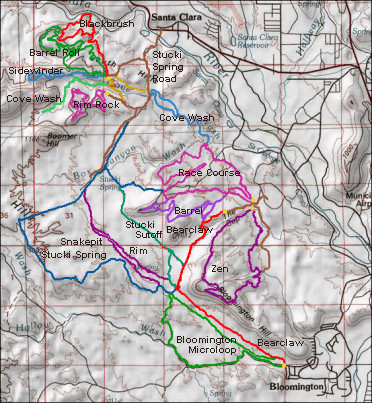Stuki Springs Trail
Just west of the St. George city limits, and below the Shinarump mesa top rides, the Stuki springs trail is a roll and flow clay singletrack (and degrading doubletrack) through classic Mojave desert terrain. With very low technicality and mostly gentle climbing the trail is suitable for begininer riders with a good level of endurance, and reasonable bike handling skills.
Stuki springs is a longer loop extension off of the bearclaw poppy trail, and utilizes the outbound wash uphill, and downhill rolling return to return to the Navaho road trail head parking. There are numerous riding options that have been developed that offer a wide range of distances, climbing, and technicality.
Wet weather note: As all of this riding is on the soft clay of the Moenkopi layer it is imperative to stay off these trails when wet or in the winter when the freeze thaw cycle will result in sticky gumbo possibly for weeks on end. Beyond making a sticky mess of your bike you will be leaving grooves in the trail that once dry will preserve your impatience for months.
Classic Stuki Springs loop
The classic Stuki loop continues north from a junction 2.5 miles into the Bearclaw Poppy, and then bears right again 300 yards later staying in the wash known as the Snake pit, or Jay’s wash. This single track will travel north in and out of the wash and eventually through rolling hills to a junction with an old double track road that climbs west to the high point and beginning of approx 6 miles of rolling downhill to the parking in Bloomington via the last 3 miles of the Bearclaw Poppy trail. It is also very fun riding this loop in the clockwise direction which makes the climbing a bit less of a grind than the double track road, and offers the option of returning via either the Snake pit, Baseline, or Flowmaster trails. This loop ride is just over 11 miles and offers year round riding with the exception of periods of wet after rain or snow.
Distance: 11.2 miles
The Baseline alternate
Riding north in the snake pit (Jay’s Wash) the trail will climb out of the wash for a final time and continue along the top of a low bench. As the trail bends around to the northeast the Red mountain, and Snow Canyon will become visible as the trail enters a stand of creosote bushes. At this point it is possible to turn back to the south and ride the Baseline trail back to a junction with Clavacle hill and descend the remainder of the Bearclaw Poppy to the trail head. This option offers a shorter ride but fun fast and flowy descent through clay hill and rollers, and seems to offer the most fun downhill flow for your climbing buck
Distance: 9.8 miles
Stuki Alternate
Continuing north on the Snake pit and turning right on the Stuki springs double track will lead to Stuki spring itself, a typically moist to dry steel water tank surrounded by tamerisk bushes to the left of the single track. From the spring, turning southwest on an old double track road will require some gentle climbing for about a mile before it turns south and begins a fast and flowy descent to a junction with the Bearclaw poppy trail at Clavicle hill. Locals refer to this portion of trail as the Flow Master for its smooth and rolling nature. Though rated a beginner trail there are multiple left side junctions that offer swoopy hillside rollers that stray into intermediate terrain for the wash crossings at their bottoms.
Distance: 10.5 miles
Season: With the exception of the above wet weather note, these are year round rides, with spring and fall being optimal, and late afternoon in the winter, and early mornings in the summer often being possible in the same clothes. The Dwarf Bearclaw Poppies typically bloom in the last week of April and into the first two weeks of May.
Wildlife: This Mojave ecosystem is comprised of low shrubs, bushes and cactus species, and supports numerous bird and reptile species and a few mammals up to coyote in size. Rattlesnakes are not uncommon from mid March to early October and are typically seen in the early morning of the warm summer months. Gila Monsters are rare, but typically favor rockier terrain at the base of the mesa’s. The threatened Mojave Desert Tortoise is endemic to this area and are most active in the spring when the grasses begin to green.
Difficulty: Beginner to intermediate
Kid Friendly: Yes
Dogs: Yes
Wet Weather: NO
% Singletrack: 85%
Quality (1-5) *****

Stuki springs loop trail and options
Website links: